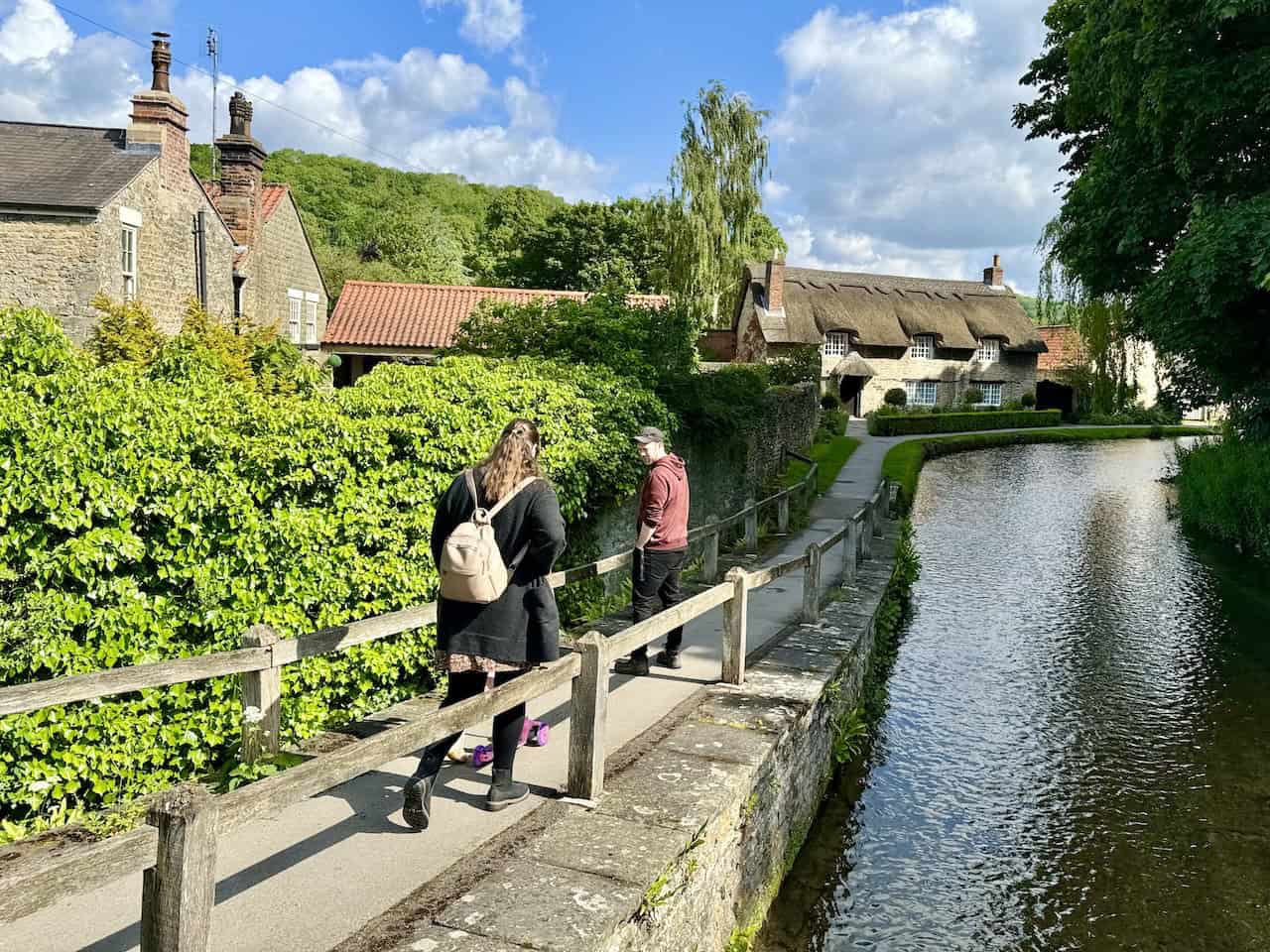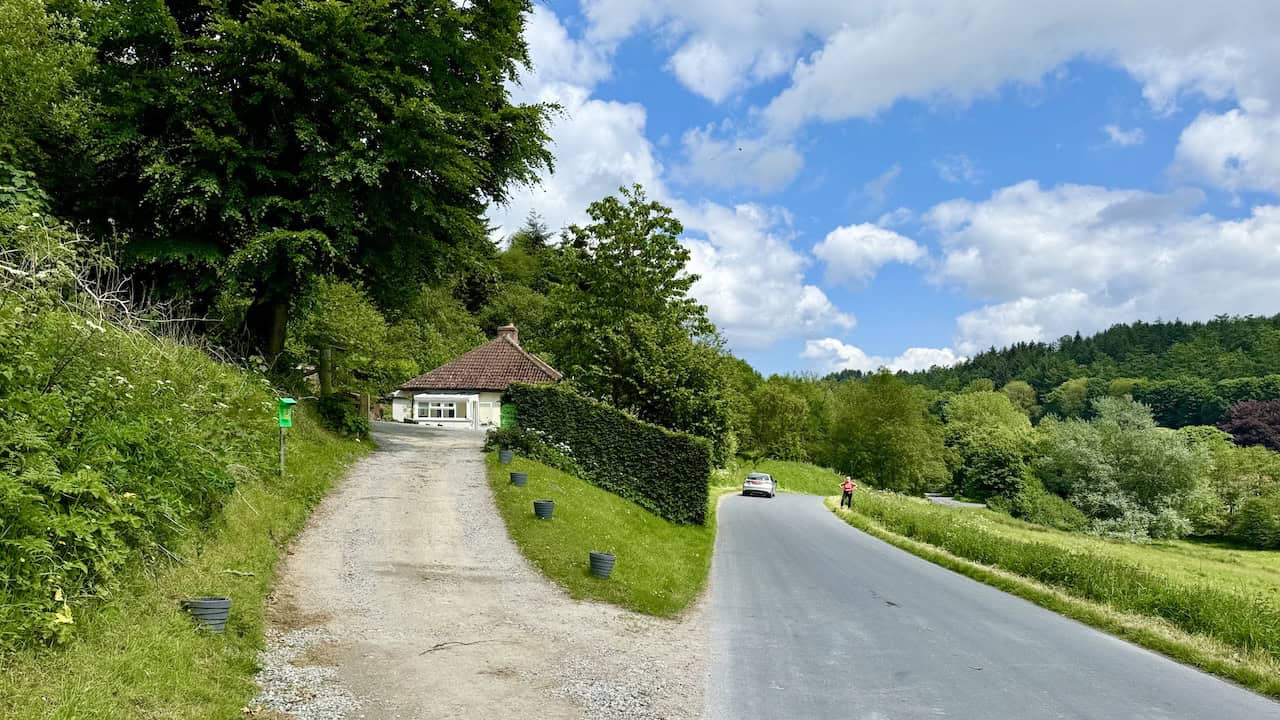Enjoy a Picturesque Dalby Forest Walk in the Heart of North York Moors
This Dalby Forest walk begins in the picturesque village of Thornton-le-Dale, located on the A170 between Pickering and Scarborough. The village, about three miles (4.8 kilometres) east of Pickering and 16 miles (25.7 kilometres) west of Scarborough, offers an excellent car park. To find it, follow the signs from the village centre crossroads, head south along Maltongate, and you’ll see the entrance on your left. The car park is hidden behind a wall that used to enclose a large walled garden.
After parking, exit the car park, pass the tranquil duck pond, and cross the beck to reach the village green. Turn right at the main road and head east through the village, passing quaint shops, inviting cafes, and the attractive almshouses. Just before the road bridge over Thornton Beck, turn left onto a footpath that guides you past the picturesque Beck Isle Cottage and alongside the beck. When you reach the road, turn left and stroll down to view the charming Thornton Mill. Retrace your steps briefly, then take the footpath on your left near the wooden footbridge.

Next, follow the path alongside Thornton Beck, heading north-west to Low Farm at Ellerburn. Walk through the farm to visit St Hilda’s Church. After visiting the church, continue east along the country lane past the fish farm and into Ellers Wood. Follow the path through the woods to reach the southern edge of Dalby Forest. Continue north along the forest track on the west side of Thornton Dale. After about a mile (1.6 kilometres), the forest track meets a tarmac road, Dalby Forest Drive. Follow this road north for about a quarter of a mile (0.4 kilometres), passing the bungalow at Nut Wood.
When the road bends right and descends to Low Dalby, take the track to your left, heading back into the forest. Walk north along the forest track, crossing a large grassy meadow, until you reach a junction, approximately the halfway point of this Dalby Forest walk. Initially, take the route signposted to Bridestones, but soon after, make a U-turn to follow the track back to a minor road, passing High Dalby House. Continue south along this road, passing Go Ape on your left. If you wish, visit the Dalby Forest Visitor Centre here.

Then, continue south, following the road through Low Dalby. Proceed straight ahead on the main forestry track, leading you back through Thornton Dale, this time on its eastern side. The forest path is easy to follow, and after a couple of miles (3.2 kilometres), you’ll exit the forest. The path veers south-west, passing Ellers Wood and High Paper Mill Farm. Take the uphill path to your left, which leads to Outgang Lane at the top. Follow this lane south, all the way back down to the A170 main road on the eastern outskirts of Thornton-le-Dale.
Finally, just before reaching the main road, turn right onto Church Lane and follow this pleasant route to All Saints Church. Walk back through the village to the car park, completing your Dalby Forest walk. This delightful 10-mile (16-kilometre) trek through the North York Moors is especially enjoyable on a fine day like ours.
Dalby Forest Walk: Maps and Tools
Visit either the OS Maps website or the Outdooractive website to view this walking route in greater detail. Both platforms offer a range of features, including the ability to print the route, download it to your device, and export the route as a GPX file. You can also watch a 3D fly-over and share the route on social media.
Dalby Forest Walk: Distance, Duration, Statistics
Distance: 9½ miles
Distance: 15 kilometres
Duration: 4 hours
Ascent: 600 feet
Ascent: 183 metres
Type: Circular walk

Recommended Ordnance Survey Map
The best map to use on this walk is the Ordnance Survey map of the North York Moors Eastern Area, reference OS Explorer OL27, scale 1:25,000. It clearly displays footpaths, rights of way, open access land and vegetation on the ground, making it ideal for walking, running and hiking. The map can be purchased from Amazon in either a standard, paper version or a weatherproof, laminated version, as shown below.
About Dalby Forest
Dalby Forest, situated on the southern slopes of the North York Moors National Park in North Yorkshire, England, is a vast woodland maintained by Forestry England. Together with Langdale Forest and Cropton Forest, Dalby Forest forms part of the North Riding Forest Park.
Dalby Forest Fauna and Flora
Dalby Forest is a haven for diverse wildlife, including badgers, roe deer, and nightjars, as well as five species of bats. The forest boasts a rich variety of tree species, such as oak, beech, ash, alder, and hazel. Notably, Sitka spruce is the predominant tree species, accounting for 30% of all trees in the forest. Additionally, the forest is home to rare plant species like narrow-leaved marsh orchids, yellow bird’s-nest, and violet crown cup.
Moreover, there are four Sites of Special Scientific Interest (SSSI) within Dalby Forest: Ellerburn Bank, Ellers Wood & Sand Dale, Seive Dale Fen, and Troutsdale & Rosekirk Dale Fens. These areas are protected due to their unique ecological significance.
Dalby Forest Geology
Dalby Forest’s landscape was once submerged under water approximately 150 million years ago, leaving behind a treasure trove of fossils that can be found throughout the region. The dominant soil type on the moorland and spurs is Middle calcareous grit, or sandstone. In other areas, Hambleton Oolite Limestone and Yedmandale Limestone, along with sandstone, are prevalent. The valley floor consists of the Oxford Clay Formation, also known as mudstone, with some peat bogs scattered throughout.
The forest spans a varied landscape, rising from a low point of 60 metres in Thornton Dale to a high point of 248 metres. Four main water valleys—Thornton Dale, Trouts Dale, Stain Dale, and Deep Dale—cut through the forest. These dales were carved by meltwater from glacial ice fields during the Devensian period, shaping the distinctive terrain we see today.
Dalby Forest History
Human activity in Dalby Forest dates back to the Bronze Age, as evidenced by the presence of burial mounds and linear earthworks of unknown purpose. Remnants of a once-thriving rabbit warrening industry also dot the landscape. In total, there are 83 scheduled and over 600 unscheduled monuments within the forest, highlighting its rich historical tapestry.
Historically, Dalby Forest was part of the Royal Hunting Forest of Pickering. The Forestry Commission acquired land around Low and High Dalby from the Duchy of Lancaster Estate in 1919 and began planting trees in 1921.
During the 1930s, the forest became a site for labour camps where unemployed men were tasked with breaking ground, building tracks, and performing other heavy labour. These men resided in a work camp at Low Dalby, one of several Instructional Centres established by the Ministry of Labour to ‘harden’ young men who had been unemployed for extended periods. By 1938, the Ministry operated 35 Instructional Centres across Britain, accommodating over 6000 men.
With the advent of World War II in 1939, unemployment decreased, leading to the closure of these work camps. Nevertheless, the layout of Dalby village still reflects the influence of the old Instructional Centre.
In a more recent historical event, Barry Prudom, a fugitive wanted for several murders, sought refuge in Dalby Forest in 1982. After evading a police manhunt, Prudom eventually holed up in Malton near the police station and, when cornered, took his own life.
Enjoying a Dalby Forest Walk
Whether you’re interested in its rich biodiversity, fascinating geology, or storied past, a Dalby Forest walk offers a unique experience for visitors. Exploring the forest on foot allows you to fully appreciate its natural beauty and historical significance. Through its varied landscapes and historical landmarks, Dalby Forest continues to captivate and inspire those who venture through its trails.
Dalby Forest Walk: My Photos
Early into our Dalby Forest walk, we encounter the charming almshouses on Church Hill in the centre of Thornton-le-Dale village. These homes, historically built for the poor and elderly, were particularly common in the Middle Ages. Founded by Lady Lumley in 1656, the almshouses in Thornton-le-Dale were later enhanced by Gerald Woffindin Hassell-Maw in memory of his ancestors, Ralph Hassell and William Maw.

Soon after passing the almshouses, we follow the footpath along Thornton Beck. This beck meanders through the village before joining the River Derwent a couple of miles to the south.

Beck Isle Cottage, nestled beside Thornton Beck in Thornton-le-Dale, is picture-postcard perfect and one of the most photographed cottages in the country. This quintessential English cottage features a thatched roof, stone walls, and white-framed, multi-paned windows.

The garden of Beck Isle Cottage is meticulously maintained, showcasing a variety of plants and small trees shaped into topiaries. A stone path leads to the front door beneath a thatched canopy, with a neatly trimmed hedge enclosing the garden.

The path continues along Thornton Beck for a short distance, offering a lovely setting early in our Dalby Forest walk. We cannot resist sitting on one of the benches to soak up the atmosphere on such a beautiful day.

Thornton Beck flows alongside Priestman’s Lane, where the charming properties are accessed via footbridges and vehicle bridges from the road.

Before taking the footpath off Priestman’s Lane towards Ellerburn, we detour slightly to visit Thornton Mill. Also known as Victory Mill, this traditional mill, once used to grind grain into flour, was powered by Thornton Beck. It now houses modern offices for businesses, and is a highlight of our Dalby Forest walk.

After admiring Thornton Mill, we backtrack slightly and take the public footpath near the footbridge. This gravel path runs between the beck and a tall hedgerow.

Thornton Beck runs around the west side of Thornton Mill. Although we can hear a waterfall, it’s unfortunately not easy to see.

Approaching Ellerburn, just north of Thornton-le-Dale, we first encounter the lychgate of St Hilda’s Church. This traditional stone entrance, with weathered stone tiles and a simple cross on the roof, welcomes us. A wooden gate and a bench with a sign inviting us to St Hilda’s Church complete the picturesque scene.

Nestled in the beautiful setting of Ellerburn is St Hilda’s Church. This historic stone-built church, with small leaded arched windows, dates back to the Anglo-Saxon period, approximately 850-950 AD. The current building, likely constructed around 1050 AD, was restored in the 20th century by W. D. Caroe, who added a vestry and porch.

The churchyard of St Hilda’s hosts a collection of gravestones and memorials, including a prominent tall obelisk war memorial to the left of the porch entrance, creating a picturesque setting.

Walking through Ellerburn, a sleepy hamlet today, we imagine its past bustling with small-scale industries such as paper mills, hemp and wool weaving, a tannery, and bleach and fulling mills. The name Ellerburn has evolved over centuries, appearing as Elreburne and Elrebrune in the 11th century, Alrebrune in the 12th century, and Ellerton in 1252 and 1316. The parish also includes the nearby township of Wilton to the south-east. Ellerburn itself now has only one farmhouse and a few cottages. It formed a joint township with Farmanby from the 14th to the 17th century, and in 1866, it was amalgamated with Thornton-le-Dale.

Although not pictured, near St Hilda’s Church lies an old fulling mill mentioned in 1650, possibly on the site of a mill existing in 1227. It stands where Ellerburn Beck flows into Thornton Beck. In 1650, five hemp yards in the district, including one belonging to Ellerburn vicarage, were also noted. A little higher up from Ellerburn are Low Paper Mill Farm, Welham Park Fish Hatchery, High Paper Mill Farm, Paper Mill Pond, and Ellers Wood.

Just past Ellerburn, we pass a fish farm. The public footpath runs by the north side of the track leading to the farm, known as Welham Park Fish Hatchery on the Ordnance Survey map.

Officially called Welham Park Trout Farms Limited, this well-established company at Low Paper Mill Farm specialises in freshwater aquaculture and is renowned for producing high-quality trout.

The narrow footpath heading north-east through Ellers Wood, just past Paper Mill Pond, is particularly beautiful today. The summer weather is perfect, and the countryside is lush and verdant.

The forestry track through the southern tip of Dalby Forest, just after leaving Ellers Wood, marks about a quarter of the way through our Dalby Forest walk.

Walking north through Dalby Forest on the forestry track, we eventually reach the minor road called Dalby Forest Drive.

We continue along Dalby Forest Drive for a short distance, passing the driveway of a bungalow at Nut Wood.

Soon after the bungalow, we leave the road and take a track on the left that leads uphill back into the forest.

Emerging from the forest a little later, we find a beautiful area of open meadowland filled with wildflowers.

At a junction in the track, we take a right turn. A nearby signpost points us towards Bridestones, while the straight-ahead route is signposted for Lockton, which is not our destination today. This marks the halfway point of our Dalby Forest walk.

After making a U-turn, we join a minor road heading south and pass High Dalby House, which offers luxury bed and breakfast and self-catering accommodation.

As we head south along the road, we pass Go Ape on our left. It looks fun, but we decide to give it a miss—perhaps in our younger days!

We arrive at the entrance to the excellent Grandfather Oak children’s play area on the north side of Dalby Forest Visitor Centre.

Next, we reach Dalby Forest Visitor Centre.

Just outside the visitor centre entrance, we admire an amazing wood carving.

From the upper balcony of the visitor centre, we enjoy a cup of tea at the café and take in the stunning view.

Heading south, we pass through Low Dalby, where there are about a dozen semi-detached properties around a large green near Dalby Forest Cycle Hub.

The forestry track heading south through Dalby Forest is beautifully lit by the sun, making our walk even more enjoyable.

Approaching High Paper Mill Farm, we marvel at how this rusty old farm building is still standing.

We follow Outgang Lane, a minor road leading back to the A170 main road on the east side of Thornton-le-Dale. Just before reaching the road, we turn right onto Church Lane.

Church Lane runs parallel to the A170 through the village, leading us to the church.

Near the end of Church Lane, we pass some delightful properties. This part of our Dalby Forest walk is particularly lovely.

All Saints Church in Thornton-le-Dale stands prominently on a hill beside the A170 Pickering to Scarborough road, overlooking the picturesque village. This Grade II listed building, largely 14th century, is unusual because, apart from the chancel, the main body of the church is completely in the ‘decorated’ style of architecture. The chancel was rebuilt in 1865-66.

Finally, we return to the bridge crossing Thornton Beck. After one last look at Beck Isle Cottage, we head to the car park, concluding our most enjoyable Dalby Forest walk.

Amazon’s Top Walking Boots: Four Standout Choices for Men and Women
For walking and hiking, the right boots are essential for both comfort and safety. While Amazon boasts a wide range, certain boots emerge as top-sellers. From those, here are four I personally favour. As an Amazon affiliate, I may earn a small commission from any purchases made through the links provided. This helps support the upkeep of this website. Rest assured, you won’t pay a penny extra, but your purchase will contribute to keeping my site running smoothly. Happy walking!

Berghaus Men’s Hillmaster II Gore-Tex Walking Boots
These fully waterproof leather walking boots feature a Gore-Tex lining, ensuring no water enters whilst allowing feet to breathe and stay cool. Made from full-grain leather, they promise unmatched durability and comfort. The boots come with memory foam tongues and cuffs that mould to your feet for a tailored fit, and the Vibram Hillmaster outsoles offer confidence on challenging terrains.

Salewa Men’s Mountain Trainer Mid Gore-Tex Walking Boots
Made from durable suede and abrasion-resistant textile, these men’s hiking boots are both lightweight and sturdy. The upper material is enhanced by a 360° full rubber sheath. Their dual-layer midsole with Bilight technology ensures ergonomic cushioning and grip, especially on extended hikes. The Vibram Wrapping Thread Combi outsoles allow a natural walking feel, and the Gore-Tex lining provides waterproofing, breathability, and optimal weather protection. Furthermore, the patented Salewa 3F system ensures flexibility, a secure heel grip, and a blister-free fit.

Berghaus Women’s Supalite II Gore-Tex Walking Boots
Specially designed for women, these hiking boots offer waterproofing and breathability, thanks to their Gore-Tex lining. Crafted from full-grain abrasion-resistant leather, they’re durable enough for the toughest hikes. The Supalite soles ensure stability and traction, and the EVA midsoles add comfort for extended walks.

Merrell Women’s Moab 3 Mid Gore-Tex Walking Boots
These hiking boots incorporate a Gore-Tex waterproof membrane, blending breathability with superior waterproof performance. The combination of pigskin leather and mesh on the uppers, along with the suede outer material, ensure durability and style. Enhancements include 100% recycled laces, webbing, and mesh lining. Additionally, bellows tongues, protective toe caps, and Vibram TC5+ rubber soles ensure protection and ease on any terrain.